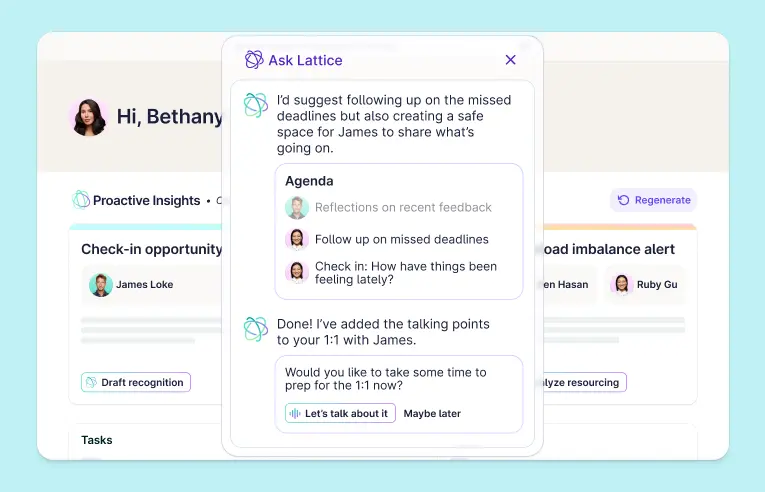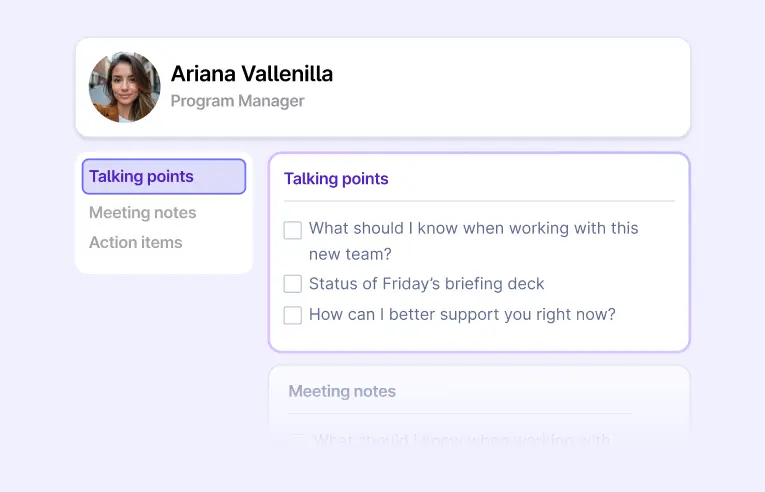Google Docs might already be at your fingertips, a flexible, no-cost platform for note-taking or collaborative planning. But when it comes to managing talent through regular one-on-ones between managers and direct reports, it quickly falls short.
That’s because effective one-on-ones require more than weekly check-ins. They should be part of a comprehensive talent management strategy that supports continuous development and provides leadership with actionable data. Unlike purpose-built one-on-one meeting software tools like Lattice 1:1s, Google Docs lacks any foundation for consistent and impactful conversations that drive organizational results.
Here’s why one-on-ones matter, why Google Docs isn’t up to the task, and how Lattice 1:1s can unlock the full potential of these critical check-ins.
Why One-on-Ones Matter More Than Ever
Employee engagement is floundering. According to Gallup’s State of the Global Workforce: 2025 Report, global employee engagement dropped to 21 percent, down two percentage points from the year before. Managers are struggling most; no other category of worker experienced as steep a decline in engagement.
Yet managers are critically important to employee development and productivity. Employees who feel even “somewhat” supported by their manager were nearly seven times more likely to report career progress in the past year than those who don’t, according to 2023 research by INTOO and Workplace Intelligence.
One-on-ones are the foundation of [our] whole approach to professional development.
Regular, high-quality one-on-ones create dedicated space for coaching, feedback, and career development, which, in turn, drives employee engagement, productivity, and retention. But one-on-ones aren’t just about performance. Open communication about stress or workload levels, for example, bolsters employee wellbeing by ensuring they’re not burned out, according to a 2023 article by Harvard Extension School.
These conversations are especially critical in hybrid and distributed environments where organic touchpoints are limited. 2023 Gallup survey data showed that disconnection from culture and decreased collaboration rank among hybrid workers’ biggest challenges. Structured, consistent one-on-ones can directly address those dynamics.
How consistent? Lattice's 2025 State of People Strategy Report looked at meeting cadence and found that weekly is the most popular choice by far.
The Impact of Well-Executed One-on-Ones
Well-executed one-on-ones impact organizations far beyond helping employees feel seen, supported, and developed. When managers are trained in best practices and given the right one-on-one meeting tool, they become better coaches. And, when one-on-ones are consistently documented, HR leaders gain insights into management effectiveness and team engagement.
Productive one-on-ones, however, require structure and integration. They need a regular cadence and clear connections to performance goals, objectives and key results (OKRs), and development plans. They should also provide leadership with actionable data to ensure consistency and quality across the workforce.
When done well, one-on-one meetings become growth-driving and culture-building rituals that everybody values. Managers can remove roadblocks, and employees have a regular forum to discuss needs and goals.
{{rich-highlight-2}}
Lattice provides a great foundation with templates, conversation starters, and more. We didn't have that before.
The Problem With Using Google Docs for One-on-Ones
For smaller organizations, Google Docs may work initially for one-on-ones. But, as companies grow, its functionality lacks the structure, workflows, and visibility required to manage one-on-ones well.
Superside, a fully distributed creative team, experienced that as its headcount grew to more than 200 people, said Miguel Vieira da Silva, the company’s head of people success. The remote team lacked visibility into its talent management and had no formal career matrices or competencies in place. Managers were expected to conduct regular check-ins with their direct reports, but there was no way for the people team to track whether productive conversations were happening.
“One-on-ones are the foundation of the whole Superside approach to professional development. It’s incredibly important that they happen,” said Vieira da Silva. “And yet, we had no idea if they were.”
Superside’s experience with Google Docs as an employee performance management tool isn’t a surprise, considering the lack of critical features within Google Docs. It offers no structure or templates for one-on-one meetings, leaving too much up to individual managers’ discretion. Without built-in frameworks, it was almost impossible to track progress, keep agendas organized, or provide HR teams visibility into the frequency or quality of one-on-ones.
What’s more, Google Docs doesn’t integrate with other talent management tools, so it’s impossible to connect one-on-ones to goals, feedback, performance reviews, or development plans. And it provides no scalable solution for training managers.
We describe ourselves as a learning organization, and Lattice helps reinforce that culture.
Why Lattice Is Built for Better One-on-Ones
By contrast, Lattice 1:1s is purpose-built for these critical conversations. It offers an integrated solution that optimizes manager effectiveness, promotes transparency, and helps companies scale a high-performance culture.
It’s also easy to use. At Superside, for example, more than 90% of employees have adopted the tool, which has given its people team unprecedented visibility. Lattice now serves as an all-in-one portal for all Superside managers, giving them access to one-on-ones, past performance reviews, and employee career plans.
“The feedback has been amazing. People are using it. I mean, of course, they are. [Lattice] is user-friendly, convenient, and easy to adopt,” Vieira da Silva said. “That was by far the most impactful thing we got from Lattice.”
Here are four ways Lattice is built better for one-on-ones than Google Docs:
1. Easy Collaboration
Within Lattice 1:1s, shared agendas allow for managers and employees to co-create action items, ensuring meetings are collaborative and high-impact. Structured meeting templates and prompts provide built-in guidance for managers and employees to ensure all topics are covered.
That enhanced support for managers has been invaluable for Fandom’s workforce. “Lattice provides a great foundation with templates, conversation starters, and more. We didn't have that before,” explained Vicky Tan, people operations manager at Fandom, the world’s largest fan platform.
2. Coaching Support
If a manager is stuck, Lattice 1:1s provides AI-powered talking points that suggest smart, relevant prompts on topics such as growth, recent feedback, or performance. Other Lattice AI features include Meeting Assist, which keeps track of meeting notes and next steps so managers can focus on coaching. Lattice also makes it easy to schedule and manage cross-functional and skip-level one-on-ones to support collaboration and transparency across teams.
“We describe ourselves as a learning organization, and Lattice helps reinforce that culture,” Tan said. “The ability to integrate continuous feedback into one-on-ones and annual reviews has been huge.”

3. Visibility and Accountability
Lattice 1:1s provides a timeline view for referencing past meeting agendas, allowing for context and continuity. As part of Lattice Performance, Lattice 1:1s also integrates with goals, performance reviews, and other forms of feedback. With it, conversations are aligned with the employee journey while giving HR team members visibility into completion rates across the organization.
For companies such as fast-growing UNREAL Snacks, Lattice has become their central HR platform, streamlining talent management across the employee lifecycle. “Everything lives in one place,” said Dominique Bauersfeld, vice president of people and business operations at UNREAL Snacks. “That saves time and builds trust in the data.”
Lattice isn’t just an HR tool...It impacts everyone across the company.
4. Streamlined Onboarding
During onboarding, Lattice prompts new hires to set up one-on-one meetings with their managers, so relationships and rituals begin in the first week. And because Lattice provides a one-stop portal for one-on-ones, goals, and reviews, new hires start steeping themselves in a culture of continuous learning and development from day one.
At UNREAL Snacks, that seamless transition from candidate to new hire has paid big dividends. Now, 25% of onboarding tasks are automated, saving the team more than an hour per new hire. And the new employees benefit, too. “Truly a best in class onboarding experience,” shared one new hire at UNREAL. “Such thoughtful detail proactively provided and throughout every step of the process!”
The move away from Google Docs or some homegrown solution has been transformative for Lattice 1:1 users, HR leaders say. “Lattice isn’t just an HR tool — it’s a Fandom tool because it impacts everyone across the company,” Tan said. “We’re already seeing tons of benefits.”
{{rich-highlight-1}}

Better Conversations, Better Performance
Book a demo of Lattice 1:1s today to improve manager-employee conversations, drive alignment, and support a high-performance culture, without relying on disconnected tools like Google Docs.
Anatomy of Effective One-on-One Meetings
Successful one-on-one meetings are:
- Consistent: Meeting cadences should be regular, whether they’re weekly, bi-weekly, or monthly, so managers maintain a pulse on team wellbeing.
- Comprehensive: Agenda items should cover real-time challenges, along with goal setting, career development, and employee concerns.
- Ongoing: Year-round one-on-ones ensure performance review conversations happen more than once a year and ensure follow-up on action items.
- Visible: HR teams can track one-on-one completion rates and participation across an organization to uncover trends or proactively intervene when challenges emerge.








